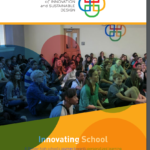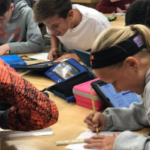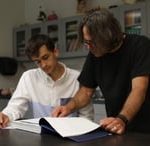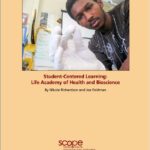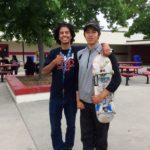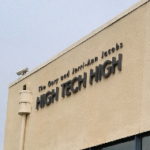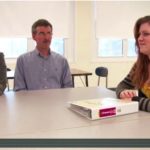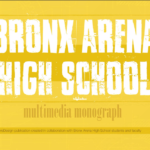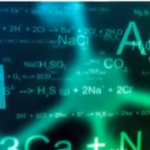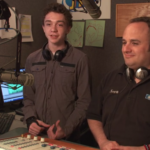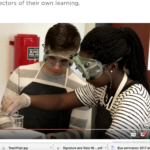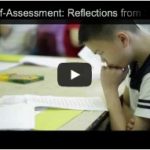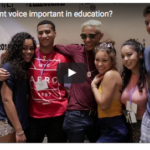This SCL continuum is an important tool for educators to identify and measure the degree to which their classroom reflects student-centered principles. By engaging with the continuum, educators can determine to what extent:
- there are personalized pathways for their students to pursue
- students are provided with clear, measurable and competency-based learning targets
- learning is leveraged beyond the traditional classroom
- lessons incorporate students’ skills and interests and successes are celebrated
Because every context is different, there is not one single purposeful path every learning environment needs to follow to achieve a high-level of student-centered learning; progressions towards SCL are more fluid in practice.
Tenet
Level
Click on one of the cards below to see a full SCL progression across levels.
Multiple pathways through content are provided and pursued, in terms of both individualized pathways through courses and individualized pathways through content within learning experiences
Educators (teachers in any setting, staff, and administrators) choose the learning activities for the class as a whole
Educators talk with students to get input about the learning activities in which students participate
Educators allow students to exercise some choice over the learning activities in which they participate, such as whether they will work in a group or individually
Students and educators work together to choose the learning activities in which students participate, thereby cultivating independence and responsibility for their own learning
Resources
Educators prescribe the order of content and experiences for the class as a whole throughout the school year
Educators talk with students about the order of content and experiences that educators choose for the class as a whole
Educators lead discussions with students to choose and plan the order of content and experiences for individual students
Students lead discussions with educators in each learning setting to choose content and experiences based on relevance and high expectations, and plan an order of content that makes sense for their learning needs and allows them to meet individualized goals
Resources
Educators do not have support to connect with students beyond their academic learning
Educators are supported with time and resources at the beginning of the school year to learn about students’ interests
Educators are supported with time and resources to make individual efforts to connect with individual students about their interests and experiences
Educators throughout the learning environment continually utilize a variety of methods to connect with students by learning about their background, interests, experiences, and perceptions
Educators provide instruction to the class as a whole, using the same instructional materials and supports for most students
Educators provide some personalized content, instructional materials, and support based on general student learning levels
Educators work to understand students’ learning levels, experiences, and interests to inform personalized content, instructional materials, and support
In partnership with students, educators in all settings engage in efforts to recognize, respect, and integrate student strengths, interests, experiences, cultural background, home context, and learning level as assets, and personalize student content, materials, and supports based on this information
Educators prescribe pathways through courses that all students follow
Educators guide students through general learning pathways in which students can choose some courses that are tailored to their learning goals
Educators collaborate with students to develop and occasionally revise individual learning plans in which pathways through learning best meet each students’ learning needs/goals (meaning some students may skip a unit or course)
All students own their educational experience and pathways through learning by working with families and educators to develop and regularly revise individual learning plans that document what, how, when, and where students learn, based upon students’ readiness, strengths, needs, and goals
Resources
* Students do not participate in advisories or group meetings (i.e., small groups of students meeting with educators to connect about their goals, interests, needs, and planning)
* Students participate in educator-directed advisories or group meetings (or similar structures) that provide time to develop personal connections
* Students collaborate with educators to co-lead advisories or group meetings that provide time for educators and students to develop connections and reflect on student learning needs and goals
* Students guide their own advisory sessions or group meetings with educators that result in deep personal connections and students making decisions about coursework, learning opportunities, and goals
Resources
* Parent-teacher conferences are run by educators and are used to highlight where students are falling short of expectations
* Parent-teacher conferences are run by educators and are used to highlight students’ areas of growth and opportunity
* Parent-teacher conferences are co-led by educators and students, and are used to highlight students’ areas of growth, opportunity, and goals
* Student-led parent-teacher conferences are designed by students and are used to locate areas of success and challenge, and the supports/resources needed to meet goals
Resources
Pacing, timing, and delivery of instruction are varied
Educators require all students in a classroom work on the same topic within a curriculum unit at the same time
Educators allow groups of students to progress through learning topics at varied paces based on grades
Educators allow individual students to progress through learning topics at varied paces based on their skill development and learning level
Students and educators collaborate to determine the pace at which students should move through learning topics, based on knowledge and skills students need to master in order to meet goals
Resources
Waukesha STEM Academy Series
* Student learning is rooted in a traditional semester/trimester schedule
* The school allows educators to suggest adjustments to student learning progression (pace + content) within the traditional semester/trimester structure
* The school allows educators to suggest adjustments to student learning progression (pace + content) in a more flexible yearly schedule/structure
* Student learning is steered by learning competencies assignments and schedules are flexible and operate without the constraints of the semester/trimester structure; they are revised regularly using assessment information
Resources
Educators require all students in a classroom to progress through units at the same pace regardless of their learning needs, and/or the school directs students into different high- and low-expectancy groups (e.g., “honors math”)
Educators allow groups of students to progress through learning topics at varied paces based on grades
Educators allow individual students to progress through learning topics at varied paces based on their skill development and learning level
Although the pace is varied, each student receives the scaffolded and differentiated support to accelerate their learning that is appropriate for reaching college, career, and life goals, even when unequal resources are required to achieve a more equitable result
Resources
Waukesha STEM Academy Series
Multiple ways for students to be assessed and demonstrate mastery are provided and pursued
Educators require all students in a classroom to show their learning by using the same assignments and assessments
Educators allow students to show their learning through a small number of different assignments and assessments
Educators allow students to show their learning through assignments and assessments that match students’ learning needs
Students collaborate with educators to create, co-design, adapt, or choose and use challenging assignments and assessments that best show their learning when they are ready to do so
Educators move on to new material on a schedule, even when some students do not meet minimum performance levels on work and assessments
When students do not meet minimum performance levels on assessments, educators provide general additional support to ensure students progress to new material on schedule
When students do not meet minimum performance levels on assessments, educators provide additional support tailored to student needs to ensure students progress to new material
Educators and students together frequently review individual student data and design additional supports to address learning needs on a schedule suited for their goals, especially when students do not meet minimum performance levels on assessments
Students submit work and assessments to educators with limited opportunities to revise
Students submit work and assessments to educators with some opportunity to revise based on feedback
Together, educators and students collaborate to review educator feedback on student work and assessments to determine if and how a student should revise
All students have the opportunity to collaborate with educators to review educator and/or peer feedback on their work and assessments (including when they do not meet minimum performance standards); students are able to revise on an agreed-upon timeline appropriate for meeting individual goals
Students are provided with and pursue clear, measurable, competency-based learning targets, rubrics, and pathways
Only a few stakeholders in the school community develop and understand what schoolwide and/or course competencies are
Some stakeholders in the school community (educators and administrators only) develop and understand what schoolwide and/or course competencies are, and how they’re taught and assessed
Some stakeholders in the learning community develop learning competencies; many stakeholders in the school community (at least students, educators, and administrators) understand what learning competencies are, and how they’re taught and assessed
A dialogue with all stakeholders in the learning community—students, educators, parents, administrators, business leaders, community members, and others—results in co-developed learning competencies focused on college, career, and life outcomes, and include explicit, measurable, transferable learning objectives that empower students
Resources
"Each and Every Learner Will Learn" (VIDEO)
Waukesha STEM Academy Series
If they exist, schoolwide and/or course competencies are not shared with or accessed by students or parents
Students and educators can access schoolwide and/or course competencies aligned to explicit learning objectives
Students and educators occasionally access and discuss clear learning competencies that are aligned to student progression toward explicit learning objectives and college- and career-readiness goals
Students, educators, parents, administrators, business leaders, and community members work collaboratively to regularly access, discuss, and use learning competencies focused on explicit learning objectives and college, career, and life goals
Resources
Waukesha STEM Academy Series
Only a few, if any, course options, learning tasks, materials, and assessments are aligned to schoolwide and course competencies
Some course options, learning tasks, materials, and assessments are aligned to schoolwide and course competencies
Many course options, learning tasks, materials, and assessments are aligned to learning competencies; student progress toward competencies is reported
Each student’s learning experience (all course options, learning tasks, materials, and assessments) is aligned to learning competencies; student learning is based on the demonstration of proficiency in each competency (and not through grades)
Resources
Waukesha STEM Academy Series
Bronx Arena High School Multimedia Monograph
* Students are organized into age-based cohorts
* Students move through course material at variable pace, but progress through grade levels with their age-based cohort
* Students are grouped by general progressions toward competencies (e.g., two traditional grade levels grouped together) rather than by age-based cohort
* Students collaborate with educators to identify where they are on their learning progressions instead of a grade construct, and collaborate with other students working toward mastering the same content, regardless of age
Resources
Students access assessments when ready to demonstrate mastery and earn credit
Students’ progression and graduation is tied to required credit hours and seat time, or competency-based methods are used to track students based on perceived ability differences
Students move ahead in their age-based cohort based on seat time and credits, but are able to access credit recovery if they are behind or engage in more challenging activities as they master content and competencies
Students’ academic progression is based on their capacity to demonstrate competencies; that is, students receive credit and move on when mastery is demonstrated, or may “test out” of some material
Students’ academic progression is based not on their age, number of days in a classroom, nor participation and effort, but based on their capacity to demonstrate core competencies in multiple ways; as a result, students of different, developmentally appropriate ages are often mixed together in the learning environment
Educators direct the assessment of course competencies without student involvement, creating grades based on average of students’ test and quiz scores, homework completion, and class participation
Educators choose how and when students are assessed on their mastery of course standards with limited student involvement
Educators lead a discussion with students about how and when to demonstrate mastery of competencies
Assessment is a meaningful learning experience: when they are ready, students lead a discussion with their educators to choose multiple performance-based tasks that demonstrate mastery of one or more competencies
Resources
Educators rely on summative assessments provided by the school or curricular materials to inform the learning and instructional strategy for the classroom as a whole
Educators rely on summative and some formative assessments provided in curricular materials on a regular basis to inform the learning and instructional strategy for each student
Educators use a variety of formative assessments aligned with learning competencies on a regular basis to inform the learning and instructional strategy for each student
Educators use multiple, frequent formative assessments—including self-assessment, exit tickets, and peer reviews—in a timely manner to engage learners in their own growth, monitor learner progress toward competencies, guide educators’ and learners’ decision-making, and to communicate with families
Resources
Bronx Arena High School Multimedia Monograph
The learning environment features high expectations and challenging tasks
Educators have high expectations for all students, but follow prescribed curriculum regardless of each students’ learning progression and challenge level
Educators have high expectations for all students, and ensure students in their classrooms access rigorous and challenging tasks
Educators hold high expectations for all students, and ensure each student accesses rigorous and challenging learning tasks and assessments aligned with competencies
The learning community (in and out of school) holds high expectations for their students, and educators recommend to students the most appropriate next steps, ensuring each student accesses rigorous and challenging learning pathways, courses, learning tasks, and assessments aligned with competencies
Learning takes place beyond the traditional school day, and even the school year. The school’s walls are permeable--learning is not restricted to the classroom.
Students rarely engage in learning activities aligned with their own interests, experiences, and real-world applications
Students engage in some learning activities outside the classroom aligned with their own interests, experiences, and real-world applications
Students engage in learning activities—both inside and outside the classroom—aligned with their own interests, experiences, and real-world applications, and goals
Students engage in authentic, meaningful learning activities—both inside and outside the classroom—that are aligned with learning competencies and their own interests, experiences, real-world applications, and goals and build connections and social capital
Resources
Students rarely engage in learning opportunities outside of formal classroom learning during the school day or school year, and receive academic credit only for classroom learning
Students engage in expanded learning opportunities outside of formal classroom learning during the school day or year, such as internships or summer projects, but do not receive credit
Students engage in expanded learning opportunities outside of formal classroom learning during the school day or year, such as internships or summer projects, for elective credit
Students engage in expanded learning opportunities outside of classroom learning during the school day or year, such as internships, community-based learning, or service-learning opportunities, for full academic credit
* Students rarely engage with community members and content experts
* Students are able to interact with community members and content experts to inform class work and projects
* Students’ learning environment expands beyond a school classroom, and students interact and build relationships with community members and content experts
* Students’ learning environment expands beyond a school building, allowing them to build connections and relationships as they interact with people and organizations that enrich student learning, and increase access to community resources and supports as part of project-based, virtual, and real-world learning experiences
Students rarely access digital technologies for note taking or research activities
Students access digital technologies in the classroom (e.g., as part of a lesson or to retrieve supplemental materials)
Students access digital technologies in the learning environment during and after school to supplement classroom learning (e.g., formative assessments online)
Students are provided with digital technologies and curriculum that enhance a rigorous learning environment while allowing them to fluidly access learning systems and learn from any location and at any time
Resources
High Tech High Network Profile
Bronx Arena High School Multimedia Monograph
Waukesha STEM Academy Series
* Educators lead classrooms in which students experience content areas as distinct subjects and school schedules are rigid based on student age
* Educators have flexibility in designing the layout and schedule of some students’ learning environment based on their needs
* Educators collaborate to design a learning environment that presents content-based concepts within and across disciplines through a variety of perspectives, including interdisciplinary projects and small-group learning
* The school’s walls and schedules are considered permeable, allowing students to have different schedules and access varied grouping strategies (e.g., individual work, small-group work, 1:1 with a mentor/teacher, interdisciplinary classes) based on students’ needs
Student-centered learning engages students in their own success—and incorporates their interests and skills into the learning process. Students support each other’s progress and celebrate success.
Educators choose the content for the class as a whole
Educators provide some choices in the content students learn
Educators encourage students to have choice in the content or setting in which they learn based on their experiences and interests
Students are active participants in their learning by frequently engaging in the design of their learning and exercising choice in the content or setting in which they learn, and take responsibility for setting and meeting goals
Resources
Educators decide the type and rigor of student learning activities and tasks
Students have the ability to develop engagement and agency by choosing from a list of challenging learning activities and tasks
Students demonstrate engagement and agency by choosing challenging learning activities and tasks that align with college- and career-readiness standards
Students are empowered to choose challenging learning activities and tasks, and can explain how these choices align with college- and career-readiness standards and goals for life beyond high school
Resources
High Tech High Network Profile
Educators rarely provide activities or lessons for students to build knowledge, attitudes, and skills necessary to learn and be successful in school and life (e.g., social-emotional skills related to achieving goals and managing emotions)
Students engage in workshops or discrete lessons to address the knowledge, attitudes, and skills necessary to learn and be successful in school and life
Students engage in integrated lessons to learn about the knowledge, attitudes, and skills necessary to learn and be successful in school and life; educators support developmentally appropriate processes used to make choices, monitor progress, and set goals
The school acknowledges a student’s ability to learn is influenced by a range of factors and the formal curriculum includes skills that prepare students to be successful; students learn to take ownership of their learning by working with educators to develop appropriate social, emotional, and life skills to be successful in achieving goals and in college and career
Resources
High Tech High Network Profile
Students rarely have the opportunity to build metacognitive strategies through activities such as creating learning activities, interpreting educator/peer feedback, and self-assessing their own learning
Educators talk with students about developing metacognitive strategies, and allow students to participate in the creation of some learning activities, interpreting educator/peer feedback, and self-assessing their own learning
Students lead collaborate discussions and educators model behavior to develop metacognitive strategies, including creating learning activities, interpreting educator/peer feedback, self-assessing their learning, and processing on defined rubrics
Students develop metacognitive strategies and steer their own learning with guidance from educators, including creating learning activities, interpreting educator/peer feedback, and self-assessing their learning and processes on defined rubrics; at the same time, educators build students’ ability to learn from peers through modeling and feedback
Resources
Educators use summative assessments to measure student learning most of the time
Educators use formative assessment to adjust instruction for groups of students
Educators use formative assessment to adjust instruction for individual students and engage students in the learning process
Students build agency by participating in frequent formative assessments to locate specific targets for improvement and to identify strategies and resources to achieve at a higher level
* Educators provide limited opportunities for students to contribute to classroom- or school-based decision-making
* Educators provide opportunities to provide input on classroom decision-making, such as activities for the day or learning modalities (e.g., tablet or group work on real-world tasks)
* Educators provide opportunities for students to contribute to decision-making processes about the immediate learning environment (i.e., classroom), including restorative circles and class meetings
* Educators provide opportunities for students to contribute to decision-making processes, including participatory action research, place-based education, restorative circles, and class meetings
Resources
References
Elements of the Personalization tenet were built upon key findings in the following sources:
Awofala, A.O. (2016). Effect of Personalisation of Instruction on Students’ Motivation to Learn Mathematics Word Problems in Nigeria. Turkish Journal of Computer and Mathematics Education, 7(3).
Black, P. & Wiliam, D. (1998). Assessment and Classroom Learning. Assessment in Education, 5(1), 7–74.
Brodersen, R.M. & Melluso, D. (2017). Summary of Research on Online and Blended Learning Programs that Offer Differentiated Learning Options. Washington, D.C.: U.S. Department of Education, Institute of Education Sciences, National Center for Education Evaluation and Regional Assistance, Regional Educational Laboratory Central, REL. Retrieved from http://ies.ed.gov/ncee/edlabs.
Friedlaender, D., Burns, D., Lewis-Charp, H., Cook-Harvey, C.M., & Darling-Hammond, L. (June 2014). Student-Centered Schools: Closing the Opportunity Gap, Stanford, Calif.: Stanford Center for Opportunity Policy in Education.
Gerard, L., Matuk, C., McElhaney, K., & Linn, M.C. (June 2015). Automated, Adaptive Guidance for K-12 Education. Educational Research Review, 15, 41–58.
Hamilton, L., Halverson, R., Jackson, S.S., Mandinach, E., Supovitz, J.A., Wayman, J.C., Pickens, C., Martin, E.S., & Steele, J.L. (2009). Using Student Achievement Data to Support Instructional Decision Making. Washington, D. C.: U.S. Department of Education.
Hughes, J.N., Luo, W., Kwok, O. & Loyd, L.K. (2008). Teacher-Student Support, Effortful Engagement, and Achievement: A 3-Year Longitudinal Study. Journal of Educational Psychology, 100(1), 1–14.
Ku, H. & Sullivan, H.J. (March 2002). Student Performance and Attitudes Using Personalized Mathematics Instruction. Educational Technology Research and Development, 50(1), 21–34.
López, C.L. & Sullivan, H.J. (December 1992). Effect of Personalization of Instruction Context on the Achievement and Attitudes of Hispanic Students. Education Technology Research and Development, 40(4), 5–14.
Marsh, J.A., Pane, J.F., & Hamilton, L.S. (2006). Making Sense of Data-Driven Decision Making In Education: Evidence from Recent RAND Research. Santa Monica, Calif.: RAND Corporation, OP-170-EDU.
May, H. & Robinson, M.A. (2007). A randomized evaluation of Ohio’s Personalized Assessment Reporting System (PARS). Philadelphia, PA.: Consortium for Policy Research in Education.
Pane, J.F., Griffin, B.A., McCaffrey, D.F., Karam, R., Daugherty, L., & Phillips, A. (2013). Does an Algebra Course with Tutoring Software Improve Student Learning? Santa Monica, Calif.: RAND Corporation, RB-9746-DEIES.
Pane, J.F., Steiner, E.D., Baird, M.D. & Hamilton, L.S. (2015). Continued Progress: Promising Evidence on Personalized Learning. Santa Monica, Calif.: RAND Corporation, RR-1365-BMGF.
Pane, J.F., Steiner, E.D., Baird, M.D., Hamilton, L.S., & Pane, J.D. (2017a). How Does Personalized Learning Affect Student Achievement? Santa Monica, Calif.: RAND Corporation, RB-9994-BMGF.
Pane, J.F., Steiner, E.D., Baird, M.D., Hamilton, L.S. & Pane, J.D. (2017b). Informing Progress: Insights on Personalized Learning Implementation and Effects. Santa Monica, Calif.: RAND Corporation, RR-2042-BMGF.
Reyes, M.R., Brackett, M.A., Rivers, S.E., White, M. & Salovey, P. (2012). Classroom Emotional Climate, Student Engagement, and Academic Achievement. Journal of Educational Psychology, 104(3), 700–712.
Ryan, A.M., & Patrick, H. (2001). The Classroom Social Environment and Changes in Adolescents’ Motivation and Engagement During Middle School. American Educational Research Journal, 38(2), 437–460.
Ryan, R.M., Stiller, J.D. & Lynch, J.H. (1994). Representations of Relationship to Teachers, Parents, and Friends as Predictors of Academic Motivation and Self-Esteem. Journal of Early Adolescence, 14(2), 226–249.
Shernoff, D.J., Tonks, S.M. & Anderson, B.G. (2014). The Impact of the Learning Environment on Student Engagement in High School Classrooms. Engaging Youth in Schools: Evidence-Based Models to Guide Future Innovations, 113(1), 166–177.
Steele, J.L., Lewis, M.W., Santibañez, L., Faxon-Mills, S., Rudnick, M., Stecher, B.M. & Hamilton, L.S. (2014). Competency-Based Education in Three Pilot Programs: Examining Implementation and Outcomes. Santa Monica, Calif.: RAND Corporation, RR-732-BMGF.
Walkington, C.A. (2013). Using Adaptive Learning Technologies to Personalize Instruction to Student Interests: The Impact of Relevant Contexts on Performance and Learning Outcomes. Journal of Educational Psychology, 105(4), 932–945.
Wentzel, K.R. (September 1997). Student Motivation in Middle School: The Role of Perceived Pedagogical Caring. Journal of Educational Psychology, 89(3), 411–419.
Yonezawa, S., McClure, L. & Jones, M. (April 2012). Personalization in Schools, The Students at the Center Series. Quincy, Mass.: Nellie Mae Education Foundation.
Elements of the Competency Based tenet were built upon key findings in the following sources:
Abakpa, B.O. & Iji, C.O. (2011). Effect of Mastery Learning Approach on Senior Secondary School Students’ Achievement in Geometry. Journal of the Science Teachers’ Association of Nigeria, 46(1), 165–176.
Bitter, C., Taylor, J., Zeiser, K. & Rickles, J. (September 2014). Providing Opportunities for Deeper Learning, Report 2: Findings from the Study of Deeper Learning, Opportunities and Outcomes. Washington, D.C.: American Institutes for Research.
Friedlaender, D., Burns, D., Lewis-Charp, H., Cook-Harvey, C.M., & Darling-Hammond, L. (June 2014). Student-Centered Schools: Closing the Opportunity Gap, Stanford, Calif.: Stanford Center for Opportunity Policy in Education.
Haynes, E., Zeiser, K., Surr, W., Hauser, A., Clymer, L., Walston, J., Bitter, C. & Yang, R. (2016). Looking Under the Hood of Competency-Based Education: The Relationship Between Competency-Based Education Practices and Students’ Learning. Washington, D.C.: American Institutes for Research.
Heller, R. & Wolfe, R.E. (December 2015). Effective Schools for Deeper Learning: An Exploratory Study. Students at the Center: Deeper Learning Research Series, Boston: Jobs for the Future.
Huberman, M., Bitter, C.,Anthony, J. & O’Day, J. (September 2014). The Shape of Deeper Learning: Strategies, Structures, and Cultures in Deeper Learning Network High Schools, Report 1: Findings from the Study of Deeper Learning, Opportunities and Outcomes. Washington, D.C.: American Institutes for Research.
Huberman, M., Duffy, H., Mason, J., Zeiser, K. & O’Day, J. (October 2016). School Features and Student Opportunities for Deeper Learning: What Makes a Difference? Report 5: Findings from the Study of Deeper Learning, Opportunities and Outcomes. Washington, D.C.: American Institutes for Research.
Kulik, C.C., Kulik, J.A. & Bangert-Drowns, R.L. (1990). Effectiveness of Mastery Learning Programs: A Meta-Analysis. Review of Educational Research, 60(2), 265–299.
Nellie Mae Education Foundation, (April 2015). Centered on Results: Assessing the Impact of Student Centered Learning. Quincy, MA.
Pane, J.F., Steiner, E.D., Baird, M.D. & Hamilton, L.S. (2015). Continued Progress: Promising Evidence on Personalized Learning. Santa Monica, Calif.: RAND Corporation, RR-1365-BMGF.
Pane, J.F., Steiner, E.D., Baird, M.D., Hamilton, L.S., & Pane, J.D. (2017a). How Does Personalized Learning Affect Student Achievement? Santa Monica, Calif.: RAND Corporation, RB-9994-BMGF.
Pane, J.F., Steiner, E.D., Baird, M.D., Hamilton, L.S. & Pane, J.D. (2017b). Informing Progress: Insights on Personalized Learning Implementation and Effects. Santa Monica, Calif.: RAND Corporation, RR-2042-BMGF.
Steele, J.L., Lewis, M.W., Santibañez, L., Faxon-Mills, S., Rudnick, M., Stecher, B.M. & Hamilton, L.S. (2014). Competency-Based Education in Three Pilot Programs: Examining Implementation and Outcomes. Santa Monica, Calif.: RAND Corporation, RR-732-BMGF.
Wachanga, S.W. & Gamba, P.P. (2004). Effects of Mastery Learning Approach on Secondary School Students’ Achievement in Chemistry in Nakuru District Kenya. Egerton Journal of Humanities, Social Sciences and Education, 5(2), 221–235.
Wambugu, P.W. & Changeiywo, J.M. (2008). Effects of Mastery Learning Approach on Secondary School Students’ Physics Achievement. Eurasia Journal of Mathematics, Science & Technology Education, 4(3), 293–302.
Zeiser, K.L., Taylor, J., Rickles, J., Garet, M.S., & Segeritz, M. (September 2014). Evidence of Deeper Learning Outcomes, Report 3: Findings from the Study of Deeper Learning, Opportunities and Outcomes. Washington, D.C.: American Institutes for Research.
[1] Elements of the Anytime, Anywhere tenet were built upon key findings in the following sources:
Billig, S.H. (2009). “Does Quality Really Matter: Testing the New K–12 Service Learning Standards for Quality Practice,” in Moely, B.E., Billig, S.H. & Holland, B.A., eds., Advances in Service-Learning Research (Vol. 9): Creating Our Identities in Service-Learning and Community Engagement. Greenwich, Conn.: Information Age.
Billig, S.H. (2000). Research on K-12 school-based service learning: The evidence builds. Phi Delta Kappan, 81(9), 658.
Billig, S.H. (2008). K-12 Service-Learning Standards for Quality Practice. St. Paul, Minn.: National Youth Leadership Council.
Bitter, C., Taylor, J., Zeiser, K. & Rickles, J. (September 2014). Providing Opportunities for Deeper Learning, Report 2: Findings from the Study of Deeper Learning, Opportunities and Outcomes. Washington, D.C.: American Institutes for Research.
Celio, C., Durlack, J. & Dymnicki, A. (2011). A Meta-Analysis of the Impact of Service-Learning on Students. Journal of Experiential Education, 34(2), 164–181.
Conway, J.M., Amel, E.L. & Gerwien, D.P. (2009). Teaching and learning in the social context: A meta-analysis of service learning’s effects on academic, personal, social, and citizenship outcomes. Teaching of Psychology,36, 233–245.
Dede, C. (December 2014). The Role of Digital Technologies in Deeper Learning. Deeper Learning Research Series. Boston: Jobs for the Future.
Eyler, J. & Giles, D.E. (1999). Where’s the Learning in Service Learning? San Francisco, Calif.: Jossey-Bass Higher and Adult Education Series.
Furco, A. (1996). Is Service-Learning Really Better Than Community Service? A Study of High School Service Program Outcomes. Retrieved from: digitalcommons.unomaha.edu.
Glowa, L. (February 2013). Re-Engineering Information Technology: Design Considerations for Competency Education.Vienna, Va.: International Association for K-12 Online Learning.
Heller, R. & Wolfe, R.E. (December 2015). Effective Schools for Deeper Learning: An Exploratory Study. Students at the Center: Deeper Learning Research Series, Boston: Jobs for the Future.
Huberman, M., Bitter, C.,Anthony, J. & O’Day, J. (September 2014). The Shape of Deeper Learning: Strategies, Structures, and Cultures in Deeper Learning Network High Schools, Report 1: Findings from the Study of Deeper Learning, Opportunities and Outcomes. Washington, D.C.: American Institutes for Research.
Huberman, M., Duffy, H., Mason, J., Zeiser, K. & O’Day, J. (October 2016). School Features and Student Opportunities for Deeper Learning: What Makes a Difference? Report 5: Findings from the Study of Deeper Learning, Opportunities and Outcomes. Washington, D.C.: American Institutes for Research.
LaBanca, F., Oh, Y.J., Lorentson, M., Jia, Y., Sibuma, B. & Snellback, M., (April 2015). Blended Instruction: Measuring the Impact of Technology-Enhanced SCL on Academic Engagement, Skills Acquisition and Achievement of Underserved Students. Quincy, Mass.: Nellie Mae Education Foundation.
Means, B., Toyama, Y., Murphy, R., Bakia, M. & Jones, K. (September 2010). Evaluation of Evidence-Based Practices in Online Learning: A Meta-Analysis and Review of Online Learning Studies. Washington, D.C.: U.S. Department of Education, Center for Technology in Learning.
Mehta, J. & Fine, S. (December 2015). The Why, What Where and How of Deeper Learning in American Secondary Schools, Deeper Learning Research Series. Boston: Jobs for the Future.
Steele, J.L., Lewis, M.W., Santibañez, L., Faxon-Mills, S., Rudnick, M., Stecher, B.M. & Hamilton, L.S. (2014). Competency-Based Education in Three Pilot Programs: Examining Implementation and Outcomes. Santa Monica, Calif.: RAND Corporation, RR-732-BMGF.
White, A.L. (2001). Meta-Analysis of Service-Learning Research in Middle and High Schools. Dissertation, Denton, Tex.: University of North Texas.
Yonezawa, S., McClure, L. & Jones, M. (April 2012). Personalization in Schools, The Students at the Center Series. Quincy, Mass.: Nellie Mae Education Foundation.
Zeiser, K.L., Taylor, J., Rickles, J., Garet, M.S., & Segeritz, M. (September 2014). Evidence of Deeper Learning Outcomes, Report 3: Findings from the Study of Deeper Learning, Opportunities and Outcomes. Washington, D.C.: American Institutes for Research.
[1] Elements of the Student Ownership tenet were built upon key findings in the following sources:
Black, P. & Wiliam, D. (1998). Assessment and Classroom Learning. Assessment in Education, 5(1), 7–74.
Boulware‐Gooden, R., Carreker, S., Thornhill, A., & Joshi, R.M. (2007). Instruction of Metacognitive Strategies Enhances Reading Comprehension and Vocabulary Achievement of Third‐Grade Students. The Reading Teacher, 61(1), 70–77.
Cardelle-Elawar, M. (1992). Effects of Teaching Metacognitive Skills to Students with Low Mathematics Ability. Teaching and Teacher Education, 8(2), 109–121.
Chamberlain, A., Daniels, C., Madden, N.A. & Slavin, R.E. (2007). A Randomized Evaluation of the Success for All Middle School Reading Program. Middle Grades Research: Journal, 2(1), 1–21.
Cross, D.R. & Paris, S.G. (1988). Developmental and Instructional Analyses of Children’s Metacognition and Reading Comprehension. Journal of Educational Psychology, 80(2), 131–142.
Dignath, C. & Büttner, G. (2008). Components of Fostering Self-Regulated Learning Among Students. A Meta-Analysis on Intervention Studies at Primary and Secondary School Level. Metacognition and Learning, 3(3), 231–264.
Flavell, J.H. (1979). Metacognition and Cognitive Monitoring: A New Area of Cognitive-Developmental Inquiry. American Psychologist, 34(10), 906–911.
Haller, E.P., Child, D.A. & Walberg, H.J. (1988). Can Comprehension be Taught? A Quantitative Synthesis of Metacognitive Studies. Educational Researcher, 17(9), 5–8.
Kramarski, B. & Mevarech, Z.R. (2003). Enhancing Mathematical Reasoning in the Classroom: The Effects of Cooperative Learning and Metacognitive Training. American Educational Research Journal, 40(1), 281–310.
Kuhn, D. & Dean, Jr., D. (2004). A Bridge Between Cognitive Psychology and Educational Practice. Theory into Practice, 43(4), 268–273.
Lai, E.R. (2011). Metacognition: A Literature Review, Always Learning Research Report. London: Pearson.
Nagaoka, J., Farrington, C.A., Ehrlich, S.B. & Heath, R.D. (June 2015). Foundations for Young Adult Success: A Developmental Framework. Concept Paper for Research and Practice. Chicago, Ill.: University of Chicago Consortium on Chicago School Research.
Pintrich, P.R. & De Groot, E.V. (1990). Motivational and Self-Regulated Learning Components of Classroom Academic Performance. Journal of Educational Psychology, 82(1), 33–40.
Schraw, G. & Moshman, D. (1995). Metacognitive Theories. Educational Psychology Review, 7(4), 351–371.
Schraw, G., Crippen, K.J. & Hartley, K. (2006). Promoting Self-Regulation in Science Education: Metacognition as Part of a Broader Perspective on Learning. Research in Science Education, 36(1-2), 111–139.
Steele, J.L., Lewis, M.W., Santibañez, L., Faxon-Mills, S., Rudnick, M., Stecher, B.M. & Hamilton, L.S. (2014). Competency-Based Education in Three Pilot Programs: Examining Implementation and Outcomes. Santa Monica, Calif.: RAND Corporation, RR-732-BMGF.
Wang, M. & Holcombe, R. (2010). Adolescents’ Perceptions of School Environment, Engagement, and Academic Achievement in Middle School. American Educational Research Journal, 47 (3), 633–662.




